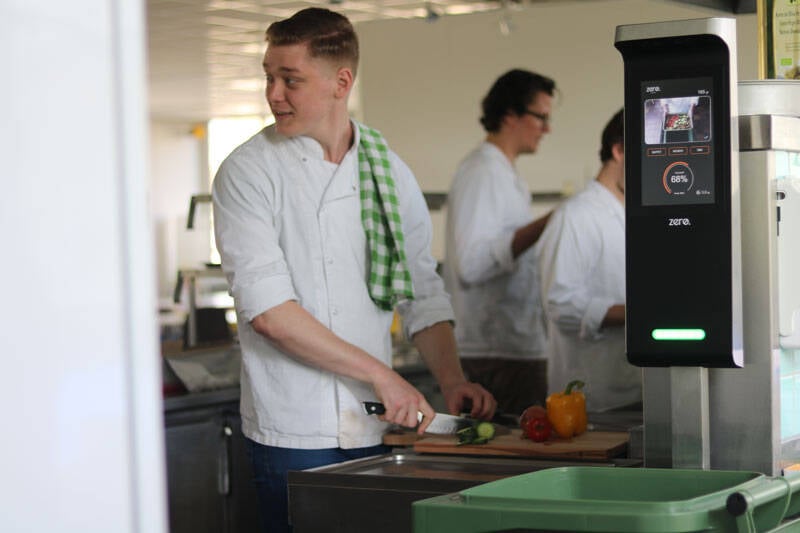
New markets and forecasting
"Ultimately, we are a data & AI company with a focus on the hospitality industry and on sustainability issues. But our core competence lies in coming up with new applications with artificial intelligence and data and analytics. There is still so much potential there, like with reducing waste within retail. But we are also looking at whether we can map patient nutrition in hospitals with our technology. Then it is no longer just about food waste but also about patient well-being and medication reduction."
“Today, food waste containers are a large describer of all of the inefficiencies in the kitchen. But together with a number of our clients, we're now pushing ourselves further by combining food waste data with their sales data, their buying figures, their guests numbers, and even circumstantial information such as the weather forecast which might impact the number of visitors. This will be the next step; to not only look back at the waste that was generated yesterday and learn from that, but also forecast what we think tomorrow's consumption will be. And that way we will nip food waste in the bud.”
"Last January we were at CES – the Consumer Electronics Show – in Las Vegas as part of the Dutch delegation. We were one of the exhibitors and used this event as a way to get a sense of how people react to our service. We immediately connected with our first customer. In fact, it’s a dream launching customer - Compass on the Microsoft campus."
"As part of the Scale NL program – a program subsidized by the Dutch government in which ten Dutch startups and scaleups have been selected as the companies with the highest potential to successfully make the step to the United States – since April, we have been participating in a pretty intensive accelerator-program. While our European organization will focus on keeping our customers happy and expanding our business further in Europe and the Middle East, I will spend a vast amount of my time building our business in the US."
The sky's the limit
“In the US, the food waste problem is even bigger than in Western Europe. We expect to be able to make a lot of impact there. The foodservice industry dynamics are quite different and in fact, very favorable to us because it is much more chain-organized. On top of that, each individual restaurant is usually a lot bigger than here in the Netherlands, which our technology lends itself well too. In the upcoming months, there's some major legislation coming up, initially in California and New York, with more strict regulations on the subject of food waste, and the need for professional kitchens to be able to report on that. So the potential is just huge."
"Apart from using a different type of plug, our solution can work anywhere. The waste bins we need to outfit might have different diameters, and there are some nuances in what type of food our camera needs to recognize, so locally we still have to learn a few things about commonly used products, but that is often not the greatest challenge. The biggest obstacle for entering a new market is getting marketing traction. Getting exposure, finding the right networks, achieving market penetration. That simply requires resources: time, patience and perseverance."
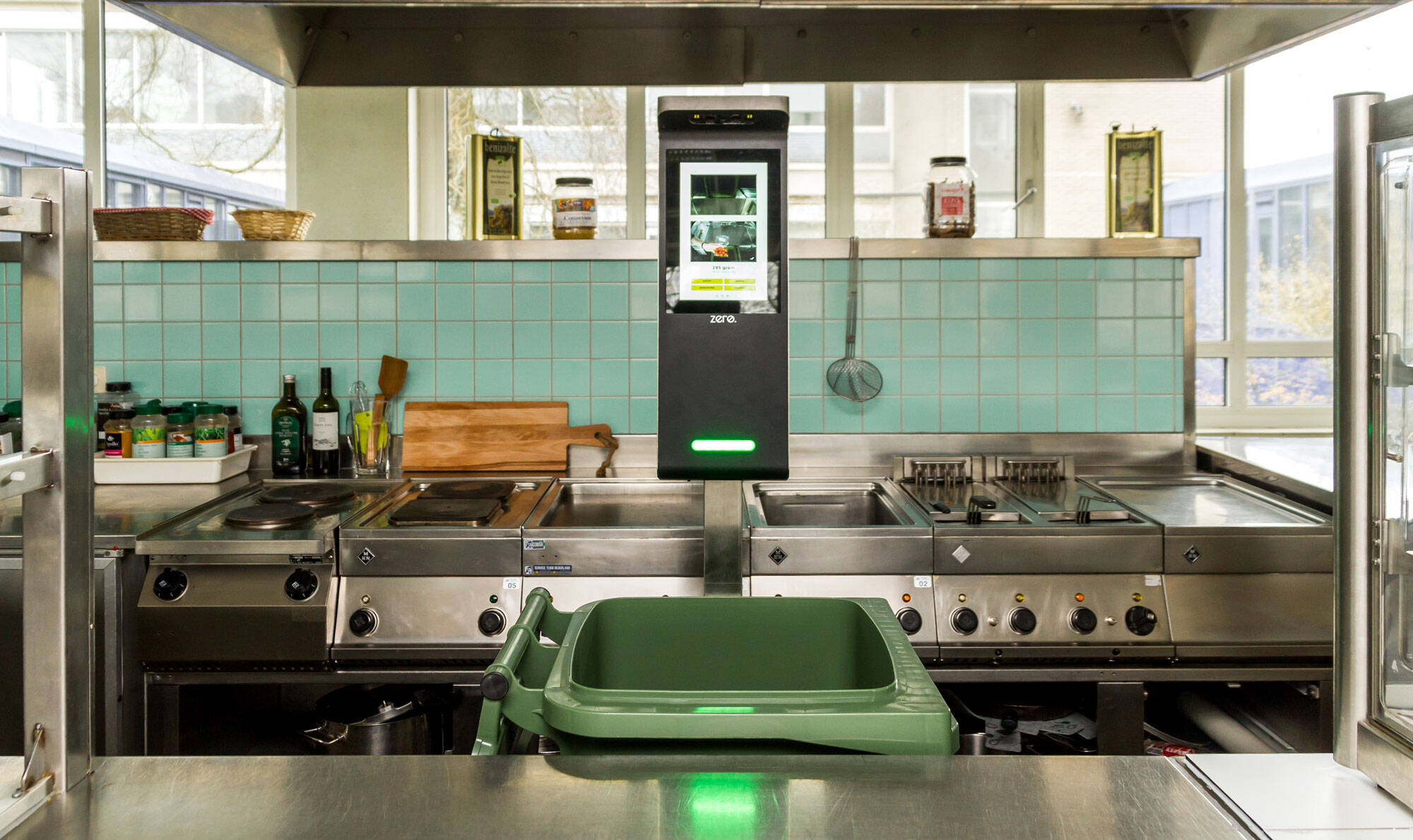
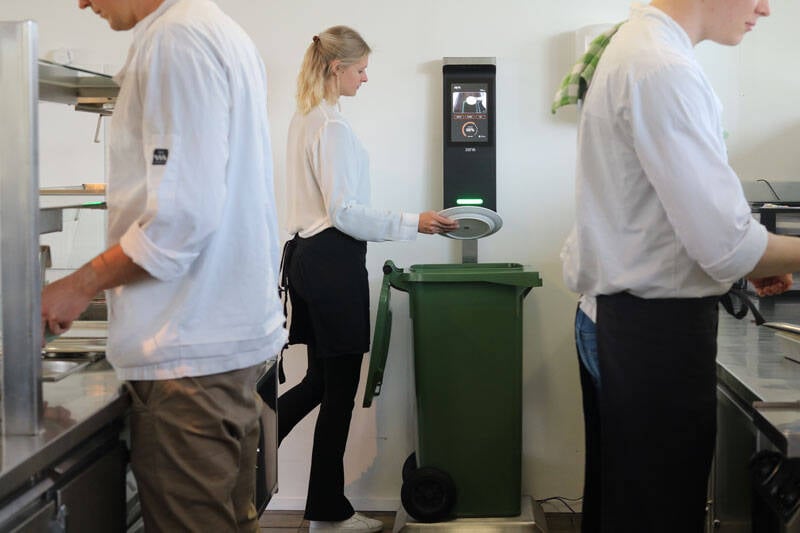
A chosen dependency
“The idea for Orbisk began at the end of 2017. I was ready to make a career switch and wanted to work on 'something in the sustainability sector’. Out of several ideas, I chose the fight against food waste. Not long after that, my friend Bart van Arnhem joined me in business. I’ve known him since I was twelve, and to this day he is the best software developer I've ever met. I told him about my ideas, asked him for some advice and next thing I knew, he suggested joining me in building the platform. He joined at the beginning of 2018. At first we worked on Orbisk in the hours after our jobs; I still worked at retailer Albert Heijn and he worked at an IT company. At the beginning of 2019, we quit our jobs to focus completely on building Orbisk. In May 2019, my former Albert Heijn colleague Richard Beks joined our team: Richard is now co-founder and our commercial conscience.”
“In August 2019, we hired our first employee and had five to ten customers. Eight months later we had grown to a team of 20 people and serviced 50 customers. But then in March 2020, our customers' world collapsed and with it our own. In retrospect, we managed to survive during the pandemic – almost two years – with government support and a number of kind investors. Every time there were some relaxations in the Corona measures, we could get back to work right away, and we often had 30 to 40 devices running again within a month. And then everything closed down again – that happened twice. Now, we hope we have finally put that behind us, and we are growing at a very fast pace again. At the beginning of January we had 20 installations running, and by June we had about 120 installations operational. By the end of the year we expect our equipment to be installed at 250 to 300 locations.”
“The crisis has taught us a number of lessons. Someone pointed this out to me - every time there is a crisis, the restaurant industry is the first sector to feel the pain. I had never thought about this so explicitly, but it is the reality that our customers constantly deal with. However, that is not a reason for us to turn our backs on the sector. On the contrary, we have chosen this as our primary market and we will continue doing so. The reason we really stick to that is because the restaurant and catering industry is simply where the food waste problem is the biggest. There is a lot to optimize there.”
The average restaurant in the Netherlands – according to our figures – throws away about 10,000 kg of edible waste per year; we can generally reduce this by 50%. So you are talking about 5,000 kg, while the average kilo (before corona) costs about 5.50 euros. Recently this has increased considerably with rising food prices. Consider that saving 5,000 kg, would result in a saving of 25,000 to € 30,000 and now even more than that. The annual fee for the use of our service usually has a return on investment of two to ten times.
A team effort
“We deliver a hightech plug-and-play solution for daily use. We do not require any additional kitchen space or infrastructure. We outfit your existing waste bin and you can keep it in the exact same space as you always did. The data is sent to the Cloud automatically via a mobile or Wifi network. We explicitly call our solution ‘a service’. We provide restaurants with the hardware, which is a lease-lend construction, we give you access to your data dashboard, but we also train every individual kitchen team for a 100-day period. Chefs are not data scientists like the people on my team are. They like to be with their guests, not behind a computer. With the training, we help them to interpret the data and leverage it to their advantage whilst not taking too much of their time. For example, we show them where we see structural waste occur in their process and help them to identify possible improvements. We provide an online knowledge library where chefs can find some of our solutions. We also train chefs on how to engage their teams because reducing waste really is a team effort.”
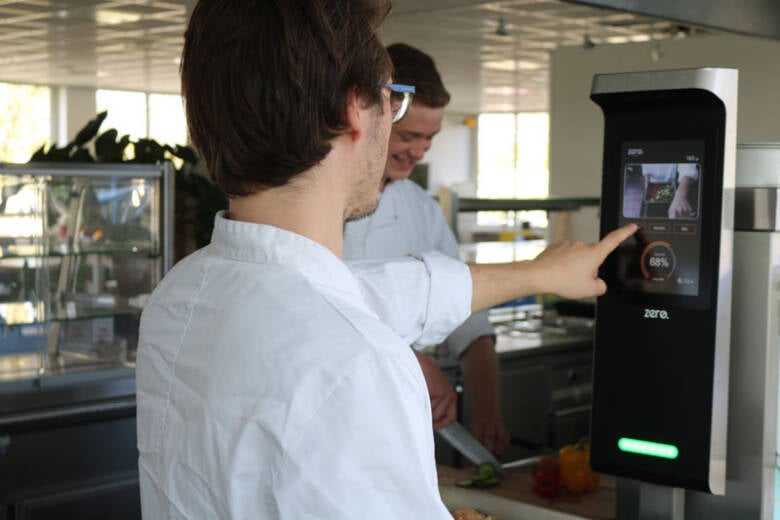
“The AI technology can identify anything that a human eye is able to. Of course, if a chef creates a dish that is plated in a unique way, the AI technology won't be able to identify that dish in detail. But different kinds of greens, like zucchini and cucumber for example, are distinctive enough to be identified separately. The AI technology works a bit like the neural network in a human brain. It identifies the structure, the shape, the colors and so on, looking for specific characteristics on many different levels.”
“Right now our application has a 24 hour turnaround time for the data to reach the user. But instant turnaround is what we have in mind while we are developing our tool even further. It’s why we outfitted the device with a screen in the first place. It's all about behavioral change; the data collection and dashboard are just the start. The service will become even more powerful if we can nudge every single person working in the kitchen towards structural behavioral change. The moment that the bin you are using gives you an instantaneous hint ‘you are now wasting x euros worth of good food’ or ‘you are doing x% better than last week on this day,’ will be really powerful. It will create awareness of the value of waste. That will be a game changer.”
Distinguishing zucchini from cucumber
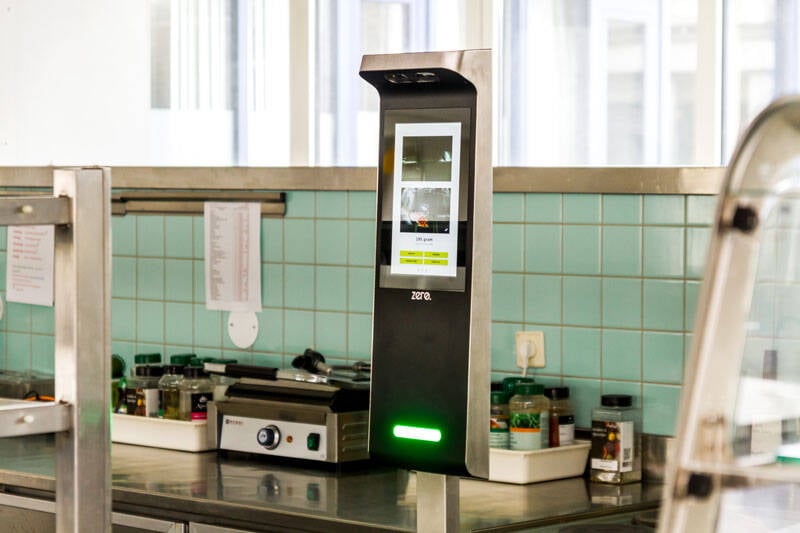
“There's a number of things that our software can identify in those pictures: the type of food, the amount of food, the level of processing (prepared, whole or cutting waste), the time of disposal and the reason for disposal. It can determine if the food comes from a pan, a cutting board, a metal sleeve or a plate. This tells you where and in what part of the process the food was lost. A waste bin in the back of the house is generally a very good describer of all of the inefficiencies in a kitchen. Everything ends there, unless it's eaten.”
“If you come to think of it, it’s crazy that in their restaurants, chefs and kitchen managers often have a good grip on the number of guests, the purchases and sales figures, but they have no idea on how much food they waste every day. Research shows that this can easily count up to 10% to 20% of what you purchase. People often ask us how long our intervention will take, hoping – expecting even – it to be fixed in a few months time. And although you can reduce significantly in such a period, the trick is to keep it at the low level and to do that you need to keep focus on it. Compare it to going on a diet. If you focus your attention on it, you will actually be able to lose weight, but the moment you lose that focus, you’ll gain weight again."
“Orbisk helps professional food service kitchens get a handle on their food waste by using AI image recognition technology to measure the amount of food going into the waste bin. In a fully automated and seamless way, we empower businesses to reduce their food waste while improving sustainability and profitability at the same time. We do so by outfitting the location's own waste bin(s) with a weighing scale underneath and a camera on top. Every time something is disposed of, a picture is automatically taken by the device. It takes under half a second to take the picture, that's all there is to it.”
Olaf van der Veen
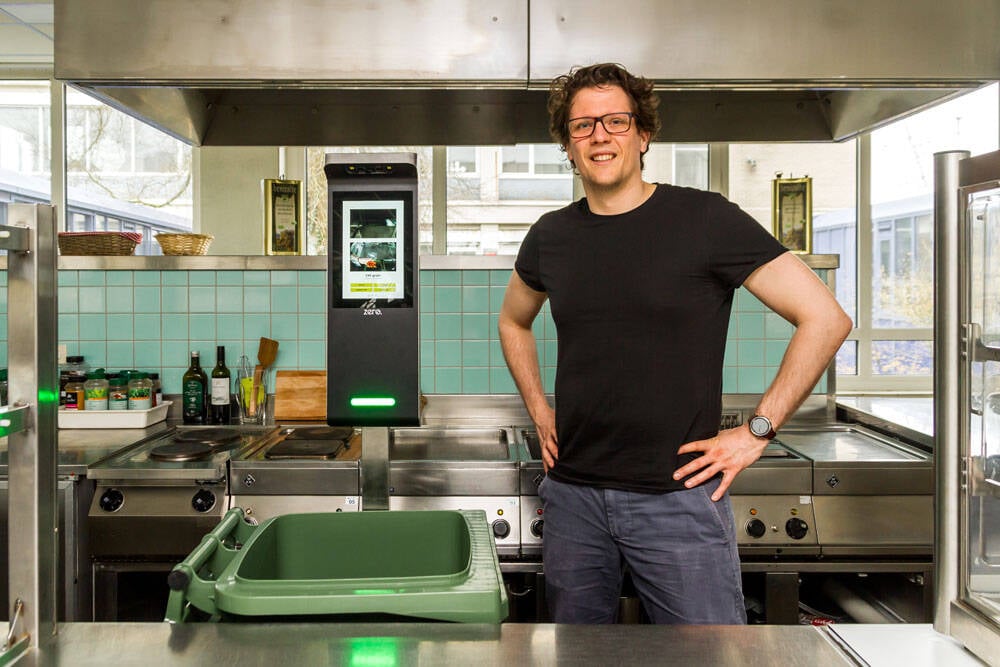
Moniek de Jongh Orbisk Xiao Er Kong
Dutch startup Orbisk is a tech company that uses AI image recognition technology to quantify food waste in professional kitchens. Orbisk’s goal is to create insight into waste streams and identify structural inefficiencies in professional kitchens in order to help reduce them. This year, the entrepreneurs behind the startup will make the leap across the ocean and start to roll out their model in the United States. We spoke to co-founder Olaf van der Veen about this exciting next step in the companies’ quest to battle food waste.
“As soon as we are able to forecast tomorrow's consumption, we will nip food waste in the bud.”
Tech startup Orbisk lets you fight food waste from your own trash
concepts
10 min
New markets and forecasting
"Ultimately, we are a data & AI company with a focus on the hospitality industry and on sustainability issues. But our core competence lies in coming up with new applications with artificial intelligence and data and analytics. There is still so much potential there, like with reducing waste within retail. But we are also looking at whether we can map patient nutrition in hospitals with our technology. Then it is no longer just about food waste but also about patient well-being and medication reduction."
“Today, food waste containers are a large describer of all of the inefficiencies in the kitchen. But together with a number of our clients, we're now pushing ourselves further by combining food waste data with their sales data, their buying figures, their guests numbers, and even circumstantial information such as the weather forecast which might impact the number of visitors. This will be the next step; to not only look back at the waste that was generated yesterday and learn from that, but also forecast what we think tomorrow's consumption will be. And that way we will nip food waste in the bud.”
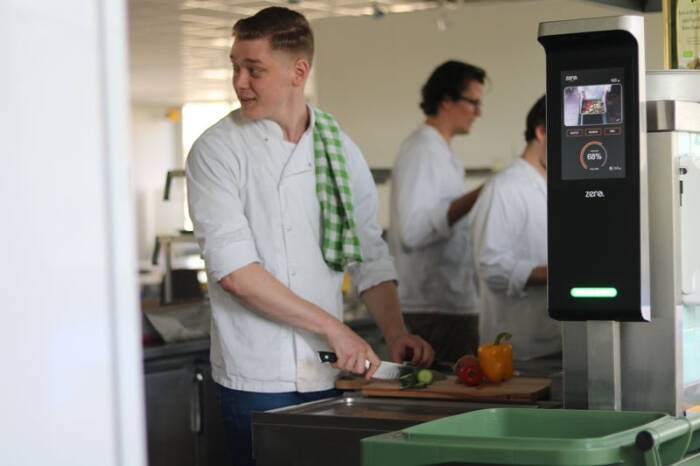
"Last January we were at CES – the Consumer Electronics Show – in Las Vegas as part of the Dutch delegation. We were one of the exhibitors and used this event as a way to get a sense of how people react to our service. We immediately connected with our first customer. In fact, it’s a dream launching customer - Compass on the Microsoft campus."
"As part of the Scale NL program – a program subsidized by the Dutch government in which ten Dutch startups and scaleups have been selected as the companies with the highest potential to successfully make the step to the United States – since April, we have been participating in a pretty intensive accelerator-program. While our European organization will focus on keeping our customers happy and expanding our business further in Europe and the Middle East, I will spend a vast amount of my time building our business in the US."
The sky's the limit
“In the US, the food waste problem is even bigger than in Western Europe. We expect to be able to make a lot of impact there. The foodservice industry dynamics are quite different and in fact, very favorable to us because it is much more chain-organized. On top of that, each individual restaurant is usually a lot bigger than here in the Netherlands, which our technology lends itself well too. In the upcoming months, there's some major legislation coming up, initially in California and New York, with more strict regulations on the subject of food waste, and the need for professional kitchens to be able to report on that. So the potential is just huge."
"Apart from using a different type of plug, our solution can work anywhere. The waste bins we need to outfit might have different diameters, and there are some nuances in what type of food our camera needs to recognize, so locally we still have to learn a few things about commonly used products, but that is often not the greatest challenge. The biggest obstacle for entering a new market is getting marketing traction. Getting exposure, finding the right networks, achieving market penetration. That simply requires resources: time, patience and perseverance."
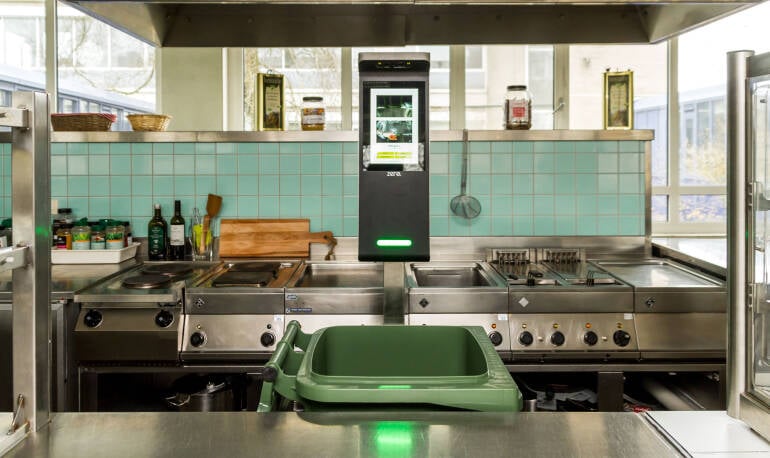
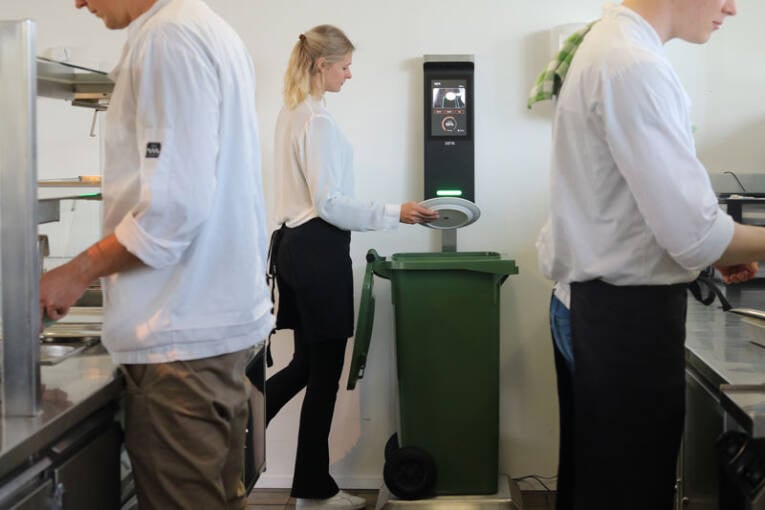
A chosen dependency
“The idea for Orbisk began at the end of 2017. I was ready to make a career switch and wanted to work on 'something in the sustainability sector’. Out of several ideas, I chose the fight against food waste. Not long after that, my friend Bart van Arnhem joined me in business. I’ve known him since I was twelve, and to this day he is the best software developer I've ever met. I told him about my ideas, asked him for some advice and next thing I knew, he suggested joining me in building the platform. He joined at the beginning of 2018. At first we worked on Orbisk in the hours after our jobs; I still worked at retailer Albert Heijn and he worked at an IT company. At the beginning of 2019, we quit our jobs to focus completely on building Orbisk. In May 2019, my former Albert Heijn colleague Richard Beks joined our team: Richard is now co-founder and our commercial conscience.”
“In August 2019, we hired our first employee and had five to ten customers. Eight months later we had grown to a team of 20 people and serviced 50 customers. But then in March 2020, our customers' world collapsed and with it our own. In retrospect, we managed to survive during the pandemic – almost two years – with government support and a number of kind investors. Every time there were some relaxations in the Corona measures, we could get back to work right away, and we often had 30 to 40 devices running again within a month. And then everything closed down again – that happened twice. Now, we hope we have finally put that behind us, and we are growing at a very fast pace again. At the beginning of January we had 20 installations running, and by June we had about 120 installations operational. By the end of the year we expect our equipment to be installed at 250 to 300 locations.”
“The crisis has taught us a number of lessons. Someone pointed this out to me - every time there is a crisis, the restaurant industry is the first sector to feel the pain. I had never thought about this so explicitly, but it is the reality that our customers constantly deal with. However, that is not a reason for us to turn our backs on the sector. On the contrary, we have chosen this as our primary market and we will continue doing so. The reason we really stick to that is because the restaurant and catering industry is simply where the food waste problem is the biggest. There is a lot to optimize there.”
The average restaurant in the Netherlands – according to our figures – throws away about 10,000 kg of edible waste per year; we can generally reduce this by 50%. So you are talking about 5,000 kg, while the average kilo (before corona) costs about 5.50 euros. Recently this has increased considerably with rising food prices. Consider that saving 5,000 kg, would result in a saving of 25,000 to € 30,000 and now even more than that. The annual fee for the use of our service usually has a return on investment of two to ten times.
A team effort
“We deliver a hightech plug-and-play solution for daily use. We do not require any additional kitchen space or infrastructure. We outfit your existing waste bin and you can keep it in the exact same space as you always did. The data is sent to the Cloud automatically via a mobile or Wifi network. We explicitly call our solution ‘a service’. We provide restaurants with the hardware, which is a lease-lend construction, we give you access to your data dashboard, but we also train every individual kitchen team for a 100-day period. Chefs are not data scientists like the people on my team are. They like to be with their guests, not behind a computer. With the training, we help them to interpret the data and leverage it to their advantage whilst not taking too much of their time. For example, we show them where we see structural waste occur in their process and help them to identify possible improvements. We provide an online knowledge library where chefs can find some of our solutions. We also train chefs on how to engage their teams because reducing waste really is a team effort.”
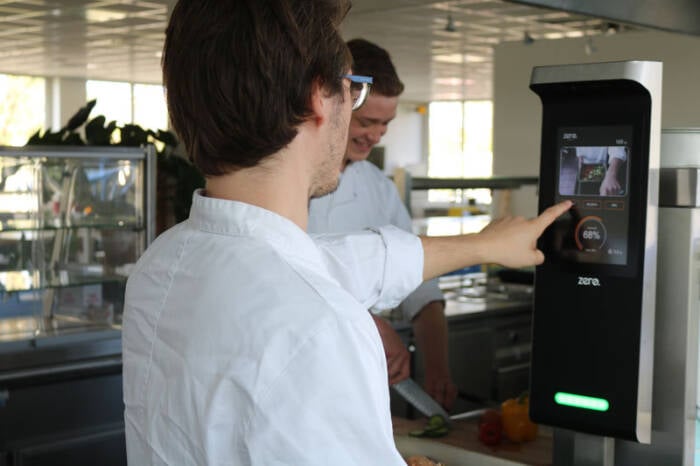
“The AI technology can identify anything that a human eye is able to. Of course, if a chef creates a dish that is plated in a unique way, the AI technology won't be able to identify that dish in detail. But different kinds of greens, like zucchini and cucumber for example, are distinctive enough to be identified separately. The AI technology works a bit like the neural network in a human brain. It identifies the structure, the shape, the colors and so on, looking for specific characteristics on many different levels.”
“Right now our application has a 24 hour turnaround time for the data to reach the user. But instant turnaround is what we have in mind while we are developing our tool even further. It’s why we outfitted the device with a screen in the first place. It's all about behavioral change; the data collection and dashboard are just the start. The service will become even more powerful if we can nudge every single person working in the kitchen towards structural behavioral change. The moment that the bin you are using gives you an instantaneous hint ‘you are now wasting x euros worth of good food’ or ‘you are doing x% better than last week on this day,’ will be really powerful. It will create awareness of the value of waste. That will be a game changer.”
Distinguishing zucchini from cucumber
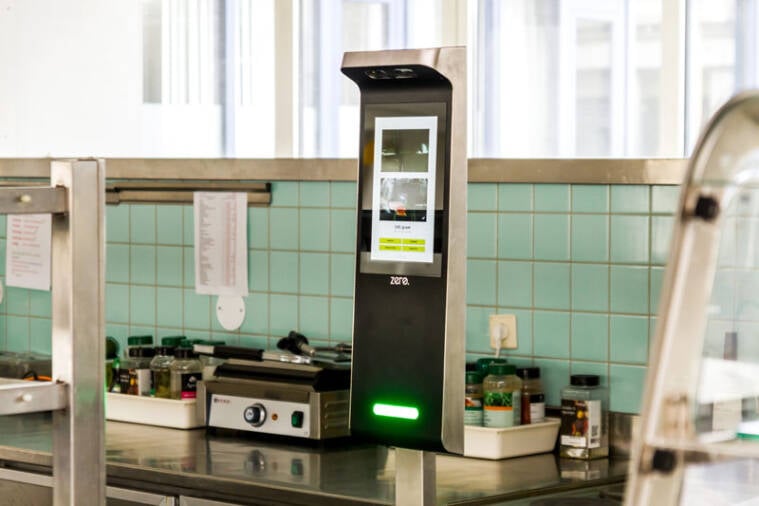
“There's a number of things that our software can identify in those pictures: the type of food, the amount of food, the level of processing (prepared, whole or cutting waste), the time of disposal and the reason for disposal. It can determine if the food comes from a pan, a cutting board, a metal sleeve or a plate. This tells you where and in what part of the process the food was lost. A waste bin in the back of the house is generally a very good describer of all of the inefficiencies in a kitchen. Everything ends there, unless it's eaten.”
“If you come to think of it, it’s crazy that in their restaurants, chefs and kitchen managers often have a good grip on the number of guests, the purchases and sales figures, but they have no idea on how much food they waste every day. Research shows that this can easily count up to 10% to 20% of what you purchase. People often ask us how long our intervention will take, hoping – expecting even – it to be fixed in a few months time. And although you can reduce significantly in such a period, the trick is to keep it at the low level and to do that you need to keep focus on it. Compare it to going on a diet. If you focus your attention on it, you will actually be able to lose weight, but the moment you lose that focus, you’ll gain weight again."
“Orbisk helps professional food service kitchens get a handle on their food waste by using AI image recognition technology to measure the amount of food going into the waste bin. In a fully automated and seamless way, we empower businesses to reduce their food waste while improving sustainability and profitability at the same time. We do so by outfitting the location's own waste bin(s) with a weighing scale underneath and a camera on top. Every time something is disposed of, a picture is automatically taken by the device. It takes under half a second to take the picture, that's all there is to it.”
Moniek de Jongh Orbisk Xiao Er Kong
Dutch startup Orbisk is a tech company that uses AI image recognition technology to quantify food waste in professional kitchens. Orbisk’s goal is to create insight into waste streams and identify structural inefficiencies in professional kitchens in order to help reduce them. This year, the entrepreneurs behind the startup will make the leap across the ocean and start to roll out their model in the United States. We spoke to co-founder Olaf van der Veen about this exciting next step in the companies’ quest to battle food waste.
Olaf van der Veen
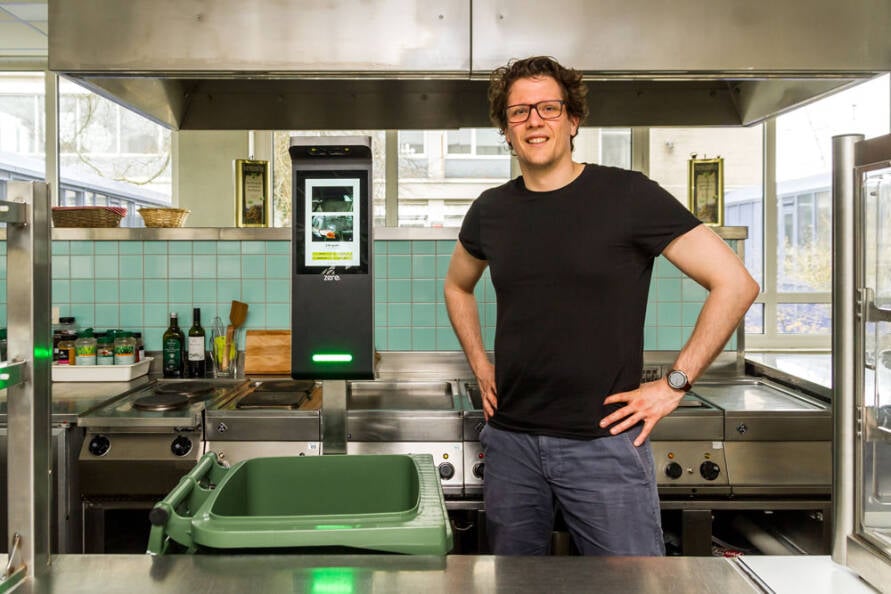
Tech startup Orbisk lets you fight food waste from your own trash
“As soon as we are able to forecast tomorrow's consumption, we will nip food waste in the bud.”
10 min









